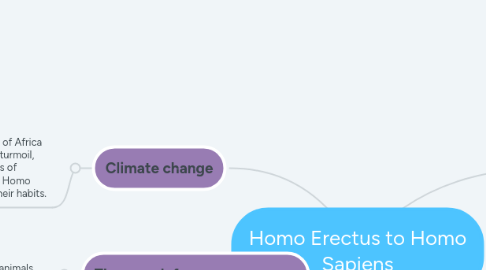Homo Erectus to Homo Sapiens
by Daniela Molina

1. Climate change
1.1. Homo sapiens migrated out of Africa at a time of intense climate turmoil, Studies suggest that periods of intense droughts motivated Homo sapiens groups to change their habits.
2. The search for new resources
2.1. that groups had to move periodically in search of various plant species to eat in different seasons of the year in (temperate regions) and different species of animals to hunt, some of which are migratory themselves. Sometimes, they had to move chasing after these animals. Along the way, some groups found new, welcoming territories to stay at. Furthermore, ya wherever they went, humans learned to eat what was around, thus providing new resources for later! (Gugliotta 2008; Haviland et al, 2010).
3. Technology
3.1. The develooment of some inventions made it possible to get to otherwise unreachable places
4. Ascent of Humankind
4.1. shows humans as the "last step". in fact this only represents one branch of a huge tree. From a biological perspective, humans are just as "advanced as dogs, cows, and cockroaches. Any plant, animal, and even fungus or bacterium that successfully survives to this dav is the latest step in hundreds of millions of vears of evolution.
5. Homo erectus
5.1. This is not unique to Homo erectus - future hominid soecies. like Homo sapiens and Homo neanderthalensis also migrated widely, settled in different territories, and mixed with other populations. We now also know that even when different species met, they often reproduced with each other, leading to genes from one species to cross into another -this is called "admixture" by geneticists (Templeton, 2007).
6. Kinship
6.1. As a soecies with language and symbolic thinking, humans developed forms of attachment to one another not seen in other species. The invisible ties between people from the sam family, or who share a common ancestor or language, are called kinship
7. Homo Sapiens and company
7.1. People often say modern humans came from Africa, Homo sapiens was not the only player in the game. As you read earlier, Homo erectus' descendants had conquered Eurasia long before. For example, around 700,000 years ago, Homo neanderthalensis split from Homo erectus and thrived from Spain to the curasian steope Meanwhile. other species lke Home denisova (sometimes considered a Neanderthal subspecies) specialized in occupying remote and otherwise isolated regions like Siberia and Tibet (Warren, 2019)
8. Factors shaping human migrations
8.1. there are a few factors that led humans and their ancestors to change territories over time
9. Avoiding danger
9.1. Besides climate change, other disastrous events like earthquakes, floods, volcanic eruotions. storms. fires, and others may have pushed human populations away from a place.
10. Human Origins
10.1. The more we know about both humans and evolution, however, the more we understand that this image is a mistaken representation of our history. Not to say that it is 100% wrone but it is easy to misinterpret
11. Agriculture and livestock
11.1. the searcn for suitable land to culuvate made migration a necessity.
12. Opportunity and ingenuity
12.1. we are able to find ways to overcome challenges, and we make the best with what we can get


